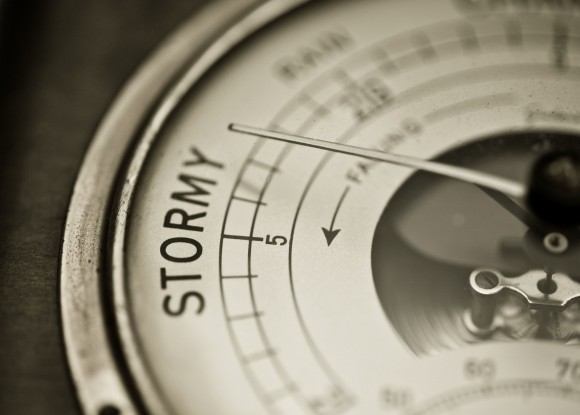A tropical depression off the coast of Florida is forecast to grow into Hurricane Arthur and strike North Carolina’s Outer Banks during the Fourth of July holiday.
The storm was stationary 95 miles (153 kilometers) southeast of Cape Canaveral, Florida, with maximum winds of 35 miles per hour as of 8 a.m. local time, the National Hurricane Center said in an advisory. Tropical storm watches were posted for Florida’s eastern coast from Fort Pierce to Flagler Beach because the system is expected to reach that level later today.
“For vacationers going out there to the Outer Banks, they will have some concerns and will have to watch this,” said Paul Walker, a meteorologist with AccuWeather Inc. in State College, Pennsylvania.
When the depression’s winds reach 39 mph it will become Tropical Storm Arthur, the first named system of the Atlantic hurricane season, which runs from June 1 through Nov. 30. Arthur’s winds are expected to peak at 75 mph, just over the threshold of hurricane strength, in the next three days.
One to 3 inches (2.5 to 8 centimeters) of rain are expected to fall across central Florida, while parts of the Bahamas may get as much as 6 inches before the system tracks north, the hurricane center said.
Category 1
After the storm passes the Outer Banks, possibly as a weak Category 1 hurricane with winds of about 75 mph, it will move northeast during the day on July 4, blocking a cold front coming across the U.S. That means Boston should receive some heavy rain, said Rob Carolan, owner of Hometown Forecast Services Inc. in Nashua, New Hampshire.
Carolan said most of the rain from the front will probably miss New York City, where the Fourth of July may start cloudy and then clear by nightfall. Any areas behind the frontal boundary, such as the vacation spots of northern New England, should also be clear.
“Anyone back behind the front will have a glorious weekend,” Carolan said.
The storm could pass very close to or possibly make landfall along the Outer Banks of North Carolina early morning on Friday. From there, the storm is forecast to continue moving northeast up the Eastern Seaboard and away from the region this weekend.
AIR Worldwide Update
As of the National Hurricane Center’s 11:00 am advisory on Tuesday, it is currently moving northwest at 2 mph (3 km/h). The system could develop into a weak Category 1 hurricane later this week, with winds of approximately 75 mph. A mid-latitude low pressure system moving in from the west pushed the storm from a stationary position to the northwest. The storm could pass very close to or possibly make landfall along the Outer Banks of North Carolina early morning on Friday. From there, the storm is forecast to continue moving northeast up the Eastern Seaboard and away from the region this weekend.
“Given the sensitivity of the track to the timing of the mid-latitude low pressure, there is still significant uncertainty in both the track and intensity forecasts at this time,” said Dr. Tim Doggett, assistant vice president and senior principal scientist at catastrophe modeling firm AIR Worldwide. “Small deviations in position and intensity over the next 24 hours could have notable impacts on the forecast for later in the week, and thus should be watched carefully.”
According to AIR, if the storm makes landfall in or bypasses North Carolina as a Category 1 hurricane, wind damage to most homes and businesses is not expected to be significant. There may be isolated instances of nonstructural damage to roof coverings and wall cladding, and windows if debris becomes airborne, as well as damage to trees, utility poles, and signage.
A tropical storm watch is in effect from Fort Pierce north to just south of Flagler Beach on the east coast of Florida. This system is expected to bring bands of rain and strong wind gusts, along with the threat of elevated surf, rip currents, and minor coastal flooding as it tracks up the Eastern Seaboard from Florida to North Carolina and farther north this Fourth of July holiday week. Heavy rains of two to four inches will likely affect the Northwest Bahamas and eastern coast of Florida Tuesday through Wednesday, with isolated pockets receiving up to six inches.
Topics Florida Catastrophe Natural Disasters North Carolina Hurricane
Was this article valuable?
Here are more articles you may enjoy.



 Dubai Floods Expose Weaknesses to a Rapidly Changing Climate
Dubai Floods Expose Weaknesses to a Rapidly Changing Climate  California Sees Two More Property Insurers Withdraw From Market
California Sees Two More Property Insurers Withdraw From Market  North Carolina Adjuster and Son Charged With Embezzlement in Roof Jobs
North Carolina Adjuster and Son Charged With Embezzlement in Roof Jobs  Trump’s Bond Insurer Tells Judge Shortfall Is ‘Inconceivable’
Trump’s Bond Insurer Tells Judge Shortfall Is ‘Inconceivable’ 

